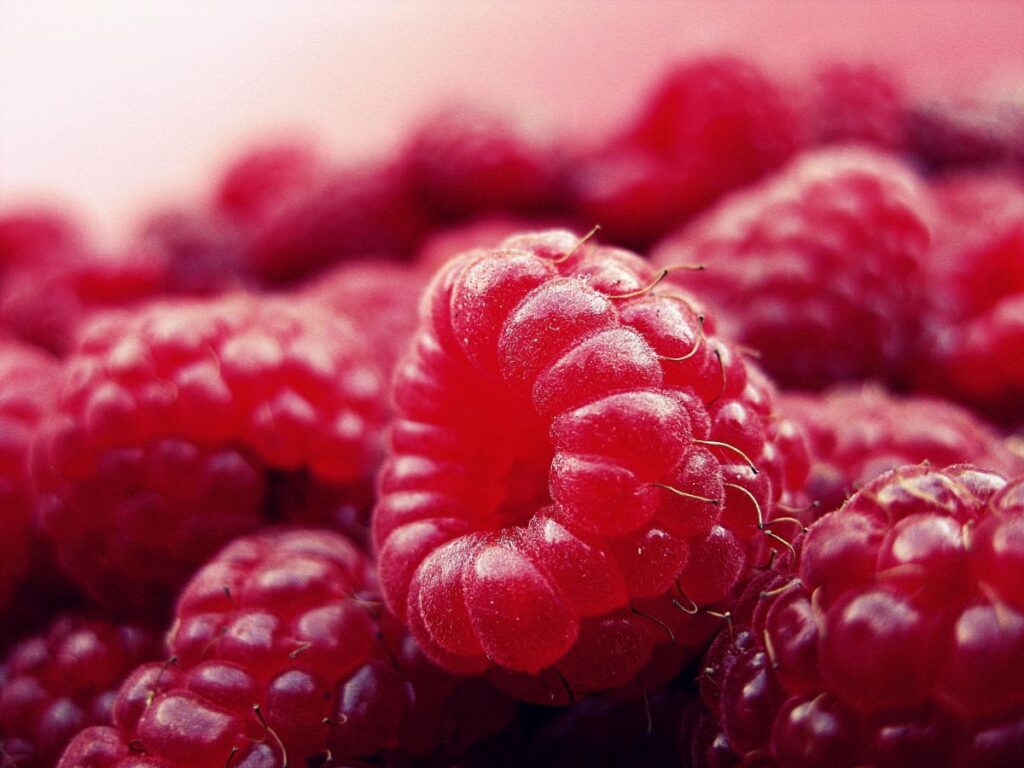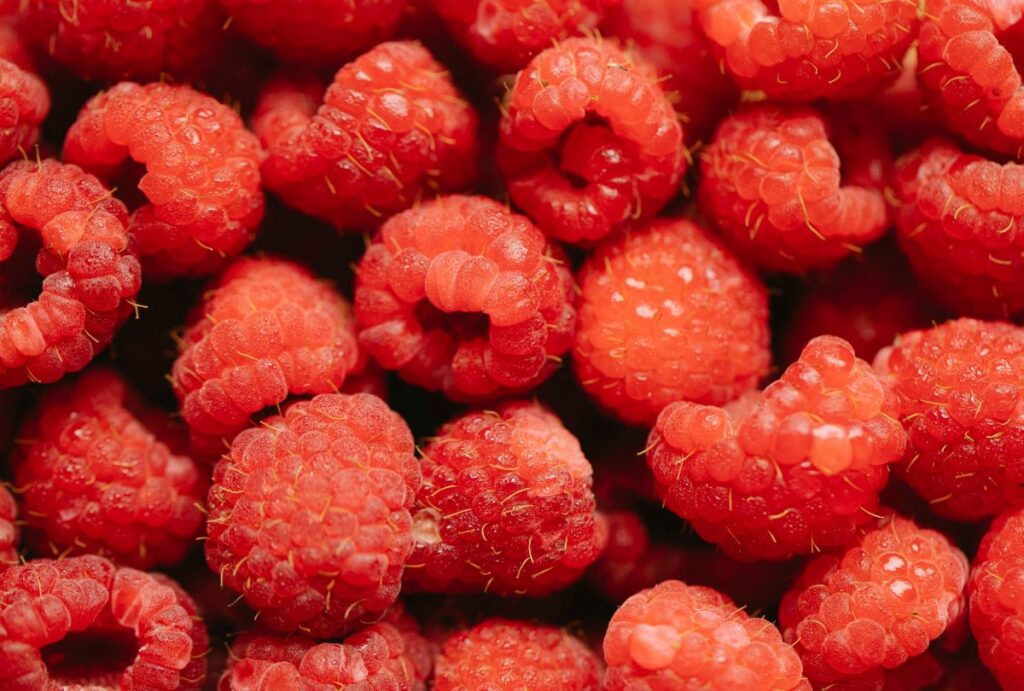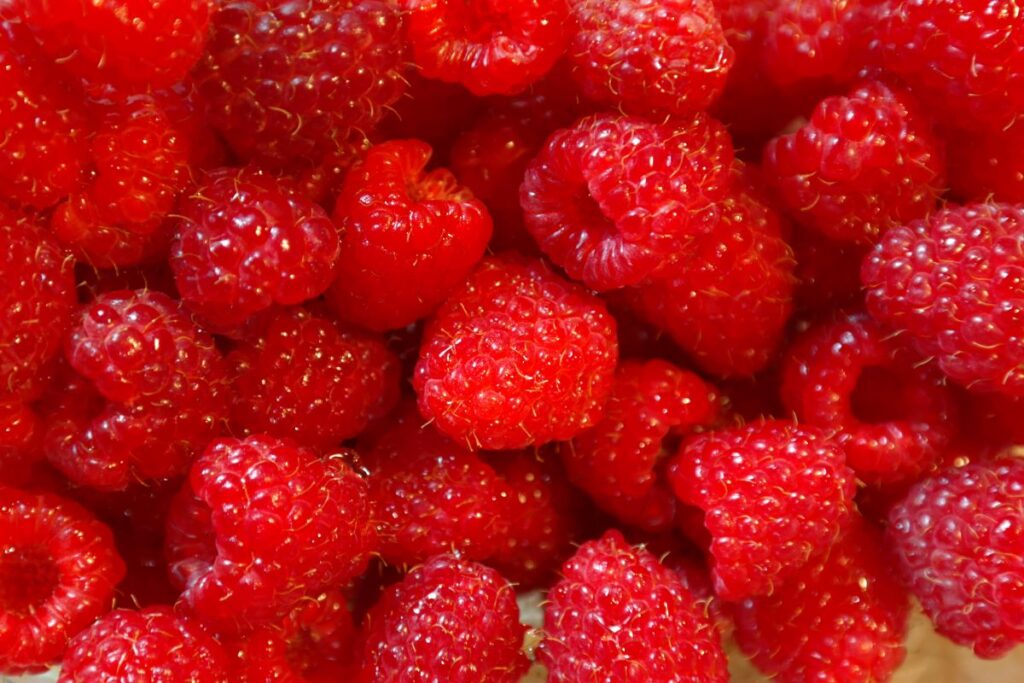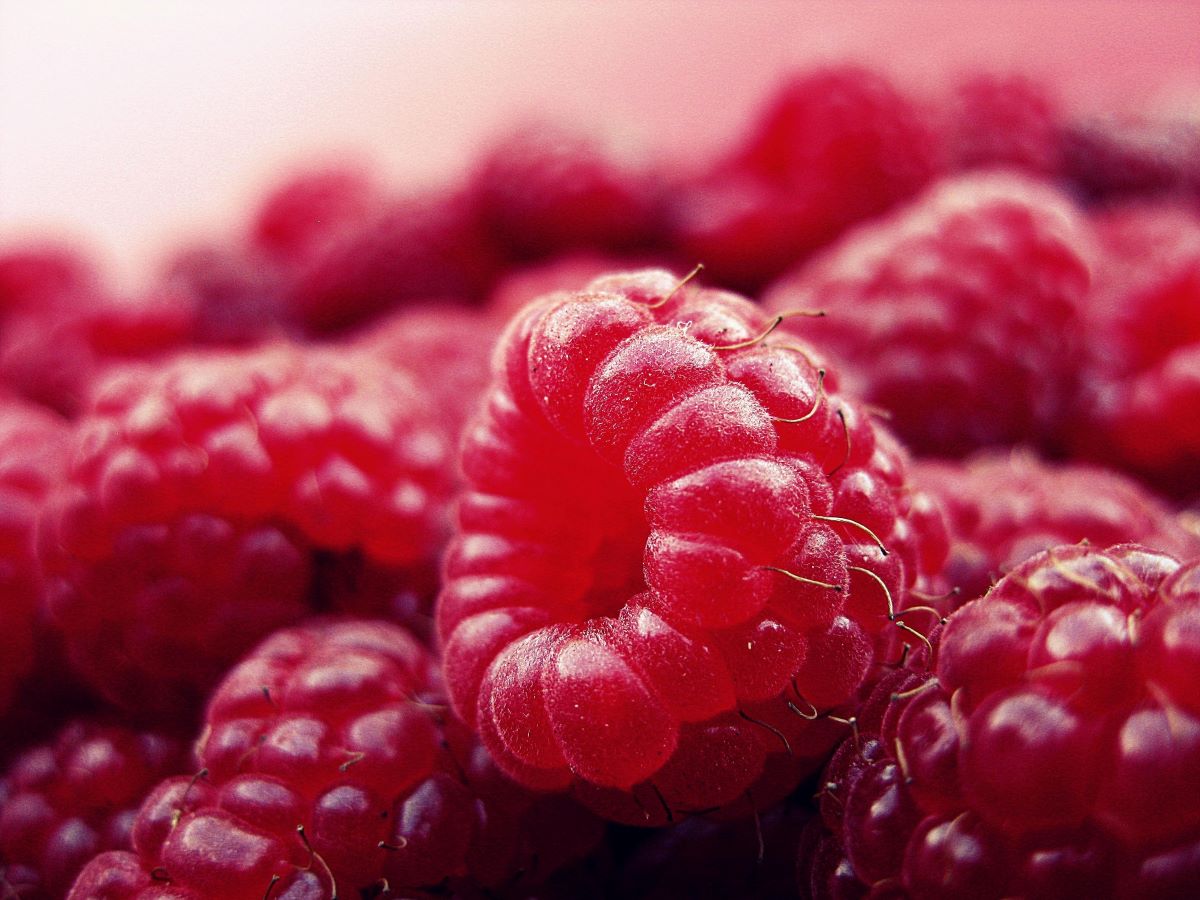Picture this. You’re walking through a summer garden. The sun feels warm on your skin. Then you spot them—bright red jewels hiding among green leaves. You reach out, pluck one, and pop it in your mouth. That sweet-tart burst of flavor is unmistakable. Raspberries!
These tiny berries hold a special place in my heart. Not just for their taste, but for how they’ve helped me stay healthy over the years. I can’t count the mornings when a handful of raspberries brightened my breakfast and gave me a natural energy boost.
Raspberries aren’t just tasty treats. They’re little powerhouses of nutrition. From fighting inflammation to helping with weight loss, these berries do it all. Let’s dive into the wonderful world of raspberries together. I’ll share what I’ve learned about their benefits, some concerns to watch for, and easy ways to add them to your meals.
Ready? Let’s start our raspberry journey!
Table of Contents
What Are Raspberries?

Raspberries are small, round berries that grow on woody shrubs. They belong to the rose family, just like strawberries and blackberries. Isn’t that surprising? Those thorny stems should have been our first clue!
Most of us know the red ones best. But did you know raspberries come in black, purple, and golden colors too? Each has its own unique taste, from sweet to tart.
The raspberry plant is quite hardy. It grows in many parts of the world with cool summers. Wild raspberries have been enjoyed for thousands of years. But farming them began much later, around the 1600s in Europe.
What makes raspberries special is their structure. Each berry is made up of tiny drupelets clustered around a central core. When you pick a ripe raspberry, the core stays on the plant, leaving a hollow center in the berry. This is different from blackberries, where the core comes with the fruit when picked.
Today, Russia, Poland, and the United States lead raspberry production worldwide. But many people grow them in home gardens too. They’re fairly easy to grow if you have the right climate and soil.
Fresh raspberries don’t last long after picking—just a few days in the fridge. That’s why frozen, dried, and canned options are so popular. They let us enjoy these berries year-round!
Read: How to Make Perfect Raspberry Jam: A Complete Guide.
Nutritional Profile of Raspberries
Let’s talk about what’s inside these tiny red gems. Raspberries pack a big nutritional punch for their small size!
A cup of fresh raspberries (about 123 grams) has:
- Calories: Only 64
- Carbs: 14.7 grams
- Fiber: 8 grams (that’s 32% of your daily needs!)
- Protein: 1.5 grams
- Fat: Less than 1 gram
Raspberries are low in calories but high in fiber. This makes them perfect if you’re watching your weight but want to feel full.
But wait, there’s more! Raspberries are loaded with vitamins and minerals:
- Vitamin C: 54% of the daily value
- Vitamin K: 12% of the daily value
- Manganese: 41% of the daily value
- Potassium, copper, and small amounts of B vitamins
The real stars in raspberries are their antioxidants. These include vitamin C, quercetin, and ellagic acid. They also have anthocyanins—the compounds that give raspberries their rich color.
What about sugar? A cup of raspberries has just 5.4 grams of natural sugar. Compare that to a banana with 14 grams or an apple with 19 grams. Raspberries have one of the lowest sugar contents among fruits!
Their glycemic index is low too—around 25. This means they don’t cause big spikes in blood sugar, making them a smart choice for people watching their glucose levels.
I find it helpful to think of raspberries as “nutrition dense” rather than “calorie dense.” Each little berry gives you a lot of health benefits without a lot of calories. That’s a win-win in my book!
Also read, Muskmelon: Nutrition, Benefits, Side Effects & More.
Health Benefits of Raspberries

The health benefits of raspberries are like finding extra money in your pocket—there’s more there than you first thought! Let me share what makes these berries so special for our health.
Rich in Antioxidants
Raspberries are packed with antioxidants. These help fight damage in our bodies caused by harmful molecules called free radicals. The main antioxidants in raspberries include:
- Vitamin C
- Quercetin
- Ellagic acid
- Anthocyanins
I notice a real difference in how I feel when I eat antioxidant-rich foods regularly. My skin looks better, and I seem to catch fewer colds too.
Heart Health Support
Your heart will thank you for eating raspberries! They can help:
- Lower blood pressure
- Reduce inflammation in blood vessels
- Improve cholesterol levels
One study found that people who ate berries had a 32% lower risk of heart attack. While that study looked at all berries, raspberries were certainly part of the picture.
Cancer-Fighting Properties
The ellagic acid in raspberries has shown promise in fighting several types of cancer cells in lab studies. While we need more research, early findings suggest that raspberries might help:
- Slow cancer cell growth
- Trigger cancer cell death
- Reduce inflammation that can lead to cancer
Brain Health Booster
As we age, keeping our brains sharp becomes more important. Raspberries might help here too! Their antioxidants can:
- Reduce inflammation in the brain
- Improve communication between brain cells
- Enhance memory and thinking skills
I’ve made it a habit to include berries in my breakfast. I like to think I’m feeding my brain along with my stomach!
Blood Sugar Management
Despite their sweet taste, raspberries are surprisingly good for blood sugar control. Their high fiber content slows sugar absorption into the bloodstream. Plus, certain compounds in raspberries may:
- Improve insulin sensitivity
- Reduce blood sugar spikes after meals
My friend with diabetes tells me that a small handful of raspberries satisfies her sweet tooth without affecting her blood sugar levels much.
Weight Management Support
Looking to manage your weight? Raspberries can be your ally! They:
- Are low in calories (just 64 per cup)
- High in fiber (8 grams per cup) to keep you feeling full
- Contain compounds that might boost metabolism
I often reach for raspberries when I want something sweet but don’t want to derail my healthy eating goals.
Digestive Health
The fiber in raspberries isn’t just good for feeling full—it’s great for your gut too! It helps:
- Feed beneficial gut bacteria
- Promote regular bowel movements
- Reduce digestive issues like constipation
After adding more raspberries to my diet, I noticed my digestion improved. Those little berries can make a big difference!
Potential Side Effects and Allergies

While raspberries offer many health benefits, they’re not perfect for everyone in every situation. Let’s look at some things to watch out for.
Allergic Reactions
True raspberry allergies are rare, but they do happen. Signs to watch for include:
- Hives or rash
- Itching around the mouth
- Swelling of lips, face, or throat
- Wheezing or trouble breathing
If you notice these symptoms after eating raspberries, seek medical help right away.
I have a cousin who developed an itchy mouth from raspberries. She was sad to give them up, but her doctor explained she had Oral Allergy Syndrome—a reaction to proteins in certain fruits that are similar to pollen proteins.
Digestive Issues
For some people, too many raspberries can cause:
- Gas
- Bloating
- Diarrhea
This is usually due to their high fiber content. If you’re not used to fiber-rich foods, start with small amounts and gradually increase over time.
Blood Thinning Effects
Raspberries contain vitamin K, which helps blood clot. But they also have compounds that might thin the blood slightly. If you take blood thinners like warfarin (Coumadin), talk to your doctor about including raspberries in your diet.
Pesticide Concerns
Non-organic raspberries may contain pesticide residues. They often make the “Dirty Dozen” list of most contaminated produce. If this concerns you, consider buying organic or growing your own.
I switched to organic raspberries a few years ago. They cost more, but I feel better knowing I’m avoiding extra chemicals. Washing thoroughly helps too, even with organic berries.
Mold Issues
Raspberries spoil quickly and can develop mold, which may produce harmful toxins. Always check berries before eating and discard any that show signs of mold.
Oxalate Content
Raspberries contain oxalates, which can contribute to kidney stones in susceptible people. If you have a history of calcium oxalate stones, talk to your doctor about how many raspberries are safe for you.
Most people can enjoy raspberries without any problems. But listening to your body is always wise. If you notice any discomfort after eating them, you might need to adjust how much or how often you have them.
How to Select and Store Raspberries
Getting the most from raspberries starts with picking the best ones and keeping them fresh. Let me share what I’ve learned over years of berry shopping!
Selecting Fresh Raspberries
When you’re at the store or farmer’s market, look for raspberries that:
- Have bright, even color (red, black, purple, or gold, depending on the variety)
- Look plump and dry, not mushy or wet
- Have no mold (check the bottom of the container!)
- Still have their small stem caps attached
- Smell sweet and fragrant
Avoid containers with juice stains at the bottom—this means crushed berries inside.
I always lift the container and look at all sides before buying. Once, I nearly missed a patch of mold hidden on the underside of the package. That quick check saved me from disappointment later!
Storing Fresh Raspberries
Fresh raspberries spoil quickly. To make them last:
- Don’t wash them until right before eating
- Keep them in their original container or a shallow dish lined with paper towels
- Store in the refrigerator at 32-36°F (0-2°C)
- Eat within 1-3 days for best quality
Even with perfect storage, raspberries rarely last more than a few days in the fridge. Their delicate nature means they bruise easily and spoil fast.
Freezing Raspberries
Freezing extends the life of raspberries by months! Here’s my method:
- Gently rinse berries and pat completely dry
- Spread in a single layer on a baking sheet
- Freeze for 2-3 hours until solid
- Transfer to freezer bags or containers
- Label with the date and use within 10-12 months
This “flash freezing” method keeps berries from sticking together, so you can take out just what you need each time.
Dried Raspberries
Dried raspberries last for months and make great snacks. Look for brands without added sugar if possible. Store in an airtight container in a cool, dark place.
I keep small bags of dried raspberries on my desk for healthy snacking at work. They satisfy my sweet tooth better than candy!
Raspberry Products
Other raspberry products to consider:
- Raspberry jam or preserves (check sugar content)
- Raspberry vinegar (great in salad dressings)
- Raspberry juice or concentrate
- Raspberry powder (can be added to smoothies)
- Raspberry extract (for baking)
These products vary widely in nutrition. Jams typically contain added sugar, while extracts have minimal nutritional value but provide flavor.
With good selection and storage practices, you can enjoy raspberries in some form year-round, not just during their short fresh season!
Raspberry Calories and Weight Management
For those watching their weight, raspberries offer big flavor with a small calorie price tag. Let’s look at how they stack up!
Calorie Count
A full cup of fresh raspberries contains just 64 calories. That’s remarkably low for something so satisfying! Compare that to:
- 1 cup of grapes: 104 calories
- 1 medium banana: 105 calories
- 1 chocolate chip cookie: about 150 calories
You get a lot of food volume for those 64 calories too—about 123 grams or a generous handful. This makes raspberries a smart choice when you want to eat something substantial without consuming too many calories.
The Satiety Factor
Despite their low calorie count, raspberries help you feel full. This is thanks to their:
- High water content (87% water)
- High fiber content (8 grams per cup)
- Physical volume
The combination of fiber and water takes up space in your stomach, sending “I’m full” signals to your brain.
I often eat raspberries before a meal. I find I’m less likely to overeat when I start with a small bowl of these filling berries.
Blood Sugar Balance
Raspberries have a low glycemic index of around 25. This means they don’t cause the sharp rise and fall in blood sugar that can lead to hunger spikes. Their fiber also slows down sugar absorption, helping maintain steady energy levels.
Metabolism Support
Some research suggests that the natural compounds in raspberries might help boost metabolism slightly. While the effect isn’t huge, every little bit helps when managing weight!
Raspberry ketones gained fame as a “weight loss miracle,” but it’s important to note that supplements contain much higher amounts than you’d get from eating the fruit. Real weight management comes from the overall pattern of eating raspberries as part of a healthy diet.
Replacing Higher-Calorie Foods
One of the best weight management strategies with raspberries is using them to replace higher-calorie foods:
- Top oatmeal with raspberries instead of brown sugar
- Blend frozen raspberries into yogurt instead of buying pre-flavored kinds with added sugar
- Make raspberry sauce for pancakes instead of using syrup
- Mix raspberries into salads to add flavor without lots of dressing
I started using raspberries to satisfy my sweet tooth instead of reaching for cookies. The natural sweetness, combined with their tartness, makes them surprisingly effective at curbing sugar cravings.
Remember that no single food causes weight loss. But adding low-calorie, high-nutrient foods like raspberries to your diet makes it easier to manage your weight in a healthy, sustainable way.
Delicious and Easy Raspberry Recipes
Now for the fun part—eating raspberries! Here are some simple, tasty ways to enjoy these berries.
Breakfast Ideas
Simple Raspberry Overnight Oats
Ingredients:
- ½ cup rolled oats
- ½ cup milk (any kind)
- ½ cup fresh or frozen raspberries
- 1 tablespoon maple syrup or honey
- Dash of vanilla extract
Steps:
- Mix all ingredients in a jar
- Cover and refrigerate overnight
- Enjoy cold in the morning
This has been my go-to breakfast on busy workdays. I make several jars on Sunday for the week ahead.
Raspberry Smoothie Bowl
Ingredients:
- 1 cup frozen raspberries
- 1 frozen banana
- ¼ cup Greek yogurt
- Splash of milk as needed
- Toppings: fresh raspberries, granola, sliced almonds
Steps:
- Blend raspberries, banana, and yogurt until thick
- Add just enough milk to keep blending
- Pour into a bowl
- Add toppings and enjoy with a spoon
Raspberry Chia Jam Toast
Ingredients:
- 2 cups raspberries (fresh or frozen)
- 2 tablespoons chia seeds
- 2 tablespoons honey or maple syrup
- 1 tablespoon lemon juice
- Whole grain toast
- Nut butter (optional)
Steps:
- Cook raspberries in a saucepan until they break down (5 minutes)
- Mash with a fork
- Stir in chia seeds, sweetener, and lemon juice
- Let cool to thicken
- Spread on toast (over nut butter if desired)
The jam keeps in the fridge for about a week. I make a batch every Sunday!
Lunch and Dinner Ideas
Raspberry Vinaigrette Salad
Ingredients:
- 2 tablespoons olive oil
- 1 tablespoon balsamic vinegar
- ¼ cup fresh raspberries
- 1 teaspoon honey
- Salt and pepper to taste
- Mixed greens
- Goat cheese
- Walnuts
Steps:
- Blend dressing ingredients until smooth
- Toss with greens
- Top with goat cheese and walnuts
Raspberry Glazed Chicken
Ingredients:
- 4 chicken breasts
- Salt and pepper
- 1 cup raspberries
- 2 tablespoons honey
- 1 tablespoon balsamic vinegar
- 1 clove garlic, minced
Steps:
- Season chicken with salt and pepper
- Cook chicken in a skillet until done
- In another pan, cook raspberries, honey, vinegar, and garlic until saucy
- Mash berries and strain if desired
- Pour glaze over chicken
This dish looks fancy but comes together in about 30 minutes. Great for impressing dinner guests!
Snacks and Treats
Raspberry Yogurt Bark
Ingredients:
- 2 cups Greek yogurt
- 2 tablespoons honey
- 1 cup fresh raspberries
- ¼ cup chopped nuts
Steps:
- Mix yogurt and honey
- Spread on a parchment-lined baking sheet
- Top with raspberries and nuts
- Freeze until solid (about 4 hours)
- Break into pieces and store in freezer
This makes a refreshing treat on hot days!
No-Bake Raspberry Energy Bites
Ingredients:
- 1 cup rolled oats
- ½ cup nut butter
- ¼ cup honey
- ¼ cup dried raspberries
- ¼ cup mini chocolate chips
- 1 tablespoon chia seeds
Steps:
- Mix all ingredients in a bowl
- Roll into small balls
- Refrigerate until firm
These keep me going during afternoon energy slumps.
Simple Raspberry Sorbet
Ingredients:
- 4 cups frozen raspberries
- ¼ cup maple syrup
- 1 tablespoon lemon juice
Steps:
- Blend all ingredients in a food processor
- Pulse until smooth but still thick
- Serve immediately or freeze for later
For a creamier version, I sometimes add a splash of coconut milk.
Drinks
Raspberry Infused Water
Ingredients:
- 8 cups water
- 1 cup fresh raspberries
- Sliced lemon or lime (optional)
- Fresh mint leaves (optional)
Steps:
- Gently crush raspberries slightly
- Add all ingredients to a pitcher
- Refrigerate for at least 2 hours
- Strain if desired and serve cold
Raspberry Lemonade
Ingredients:
- 1 cup fresh raspberries
- 4 lemons, juiced
- ¼ cup honey or sugar
- 4 cups water
Steps:
- Blend raspberries with a little water
- Strain to remove seeds
- Mix with lemon juice, sweetener, and water
- Adjust sweetness to taste
- Serve over ice
These recipes show just how versatile raspberries can be. From breakfast to dessert and everything in between, these little berries bring flavor and nutrition to any meal!
Growing Your Own Raspberries
There’s something special about picking raspberries from your own garden. It’s easier than you might think! Let me share what I’ve learned from growing my own.
Getting Started
Choose Your Variety:
- Summer-bearing (one big crop in summer)
- Ever-bearing (two crops—summer and fall)
- Red, black, purple, or golden
I grow both summer and ever-bearing types to extend my harvest season.
What You’ll Need:
- Raspberry canes or plants
- Sunny spot (at least 6 hours of sun)
- Well-draining soil
- Support system (trellis or stakes)
- Mulch
- Basic gardening tools
When to Plant:
- Early spring is best in most areas
- Fall works in milder climates
Planting Steps
- Pick a spot with good sun and shelter from wind
- Dig a hole wider than deep—about 12 inches wide and 6 inches deep
- Mix compost into the soil
- Space plants 18-24 inches apart in rows 5-6 feet apart
- Place plants so the crown is at soil level
- Water well after planting
- Add 2-3 inches of mulch around plants (not touching stems)
When I first planted raspberries, I made the mistake of crowding them. They need space to grow and for air to circulate!
Caring for Raspberry Plants
Watering:
- 1-2 inches per week, more in hot weather
- Water at soil level to keep leaves dry
- Consistent moisture is key, especially during fruiting
Fertilizing:
- Apply balanced fertilizer in early spring
- Add compost annually
- Avoid high nitrogen fertilizers that produce leafy growth but few berries
Pruning: For summer-bearing:
- After harvest, remove canes that bore fruit
- Thin remaining canes to 4-5 strong ones per foot of row
For ever-bearing:
- Option 1: Same as summer-bearing for two crops
- Option 2: Cut all canes to ground in late winter for one fall crop
The first time I pruned my raspberry plants, I was nervous about cutting so much away. But they came back stronger than ever!
Common Problems and Solutions
Pests:
- Japanese beetles: Hand pick or use organic controls
- Spider mites: Spray plants with water or insecticidal soap
- Birds: Cover with netting when fruit appears
Diseases:
- Root rot: Improve drainage
- Gray mold: Increase air circulation, remove affected berries
- Viruses: Remove and destroy affected plants
I once had a problem with birds eating all my berries. A simple net solved it, and now we share—some for the birds, more for me!
Harvesting and Yields
Raspberries are ready when they easily pull away from the plant. For best flavor, pick in the morning after dew has dried.
A mature raspberry patch can produce:
- 1-2 quarts per plant for summer-bearing
- 0.5-1 quart per plant for each harvest of ever-bearing
My small patch of six plants gives me enough berries for fresh eating plus some to freeze.
Growing raspberries takes some work, but the reward of picking sun-warmed berries straight from your garden makes it all worthwhile!
Raspberries Around the World
Raspberries have found their way into cuisines and cultures worldwide. Let’s take a tasty tour!
European Traditions
In England, raspberries and cream is a classic summer treat, especially during Wimbledon tennis season. The British also love raspberry jam as part of their traditional afternoon tea.
France has elevated the raspberry in pastry. The “framboisier” is a layered cake with raspberries and cream. French chefs also make raspberry coulis—a smooth sauce that enhances many desserts.
In Italy, “framboises” frequently appear in gelato, sorbetto, and semifreddo. The combination of raspberries and chocolate is particularly beloved in Italian pastries.
I visited Scotland once and discovered their raspberry crowdie—a sweet cheese dessert with honey, whisky, and fresh raspberries. It was delightful!
North American Uses
Native Americans were enjoying wild raspberries long before European settlers arrived. They dried the berries for winter use and used raspberry leaves for tea.
Today, Oregon and Washington lead U.S. raspberry production. The Pacific Northwest climate is perfect for growing these berries.
In Canada, raspberries feature in many preserves and syrups. Quebec is known for its ice wines and liqueurs made from local raspberries.
Asian Influences
In China, raspberry tea has been used for centuries, especially to help women through childbirth. The Chinese value both the fruit and leaves for their medicinal properties.
Japan has embraced raspberry flavors in modern cuisine, particularly in sweets like mochi and as flavoring for Kit Kat bars.
In Russia, raspberries have long been valued for fighting colds and fevers. Russian folk medicine recommends hot tea with raspberry jam for anyone feeling ill.
My Russian grandmother made a raspberry syrup that she added to hot tea whenever anyone had a sore throat. The tradition continues in our family today.
Global Products
Globally, raspberries appear in:
- Liqueurs like Chambord (France)
- Craft beers (especially Belgian lambics)
- Vinegars for gourmet cooking
- Beauty products for skin care
- Natural food dyes
The versatility of raspberries has helped them spread across cultures and continents, delighting taste buds everywhere they go!
Conclusion: The Simple Joy of Raspberries
We’ve covered a lot about raspberries—from nutrition to recipes, growing tips to global uses. But at the end of the day, what makes raspberries special is how they bring simple joy to our lives.
When I bite into a fresh raspberry, I’m not thinking about its antioxidant content or fiber levels. I’m just enjoying that perfect balance of sweet and tart, the way it melts on my tongue, and how it connects me to summer days and family memories.
Raspberries remind us to appreciate small pleasures. In our busy world, taking a moment to savor a handful of berries can be a form of mindfulness—bringing us back to the present moment through our senses.
These berries also connect us to the natural world. Whether you pick them from your garden, buy them at a farmers’ market, or select them at the grocery store, raspberries are a direct link to the soil, sun, and seasons that sustain us.
As we wrap up our journey through the world of raspberries, I encourage you to see them as more than just a food. See them as little teachers of pleasure, health, and connection.
Next time you enjoy raspberries, take a moment to really taste them. Notice their color, texture, and flavor. Remember all the goodness they bring to your body. And perhaps share them with someone you care about—because good things, even small ones like raspberries, are always better when shared.
What’s your favorite way to enjoy raspberries? However you choose to include them in your life, these tiny berries offer big rewards for your health and happiness.

